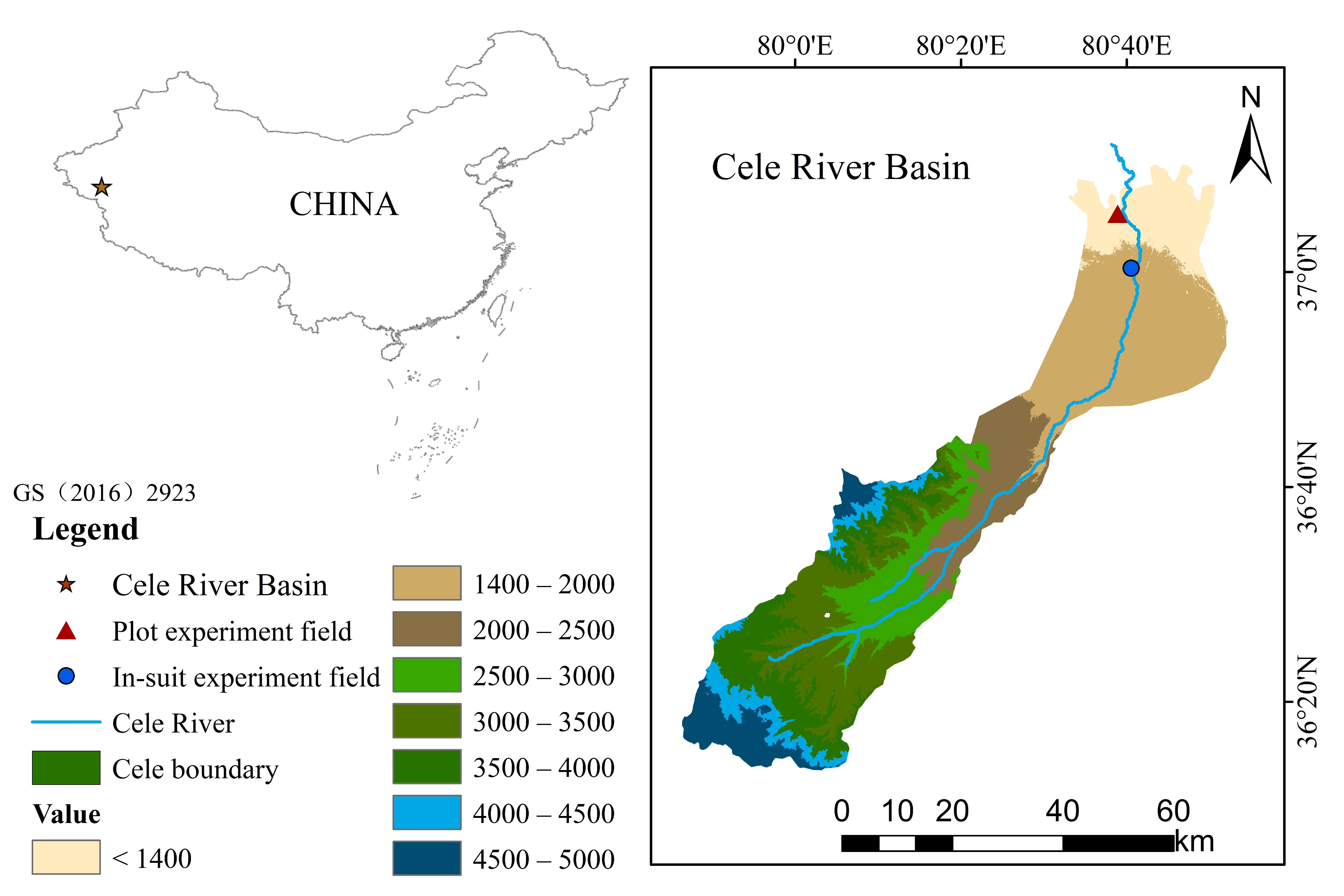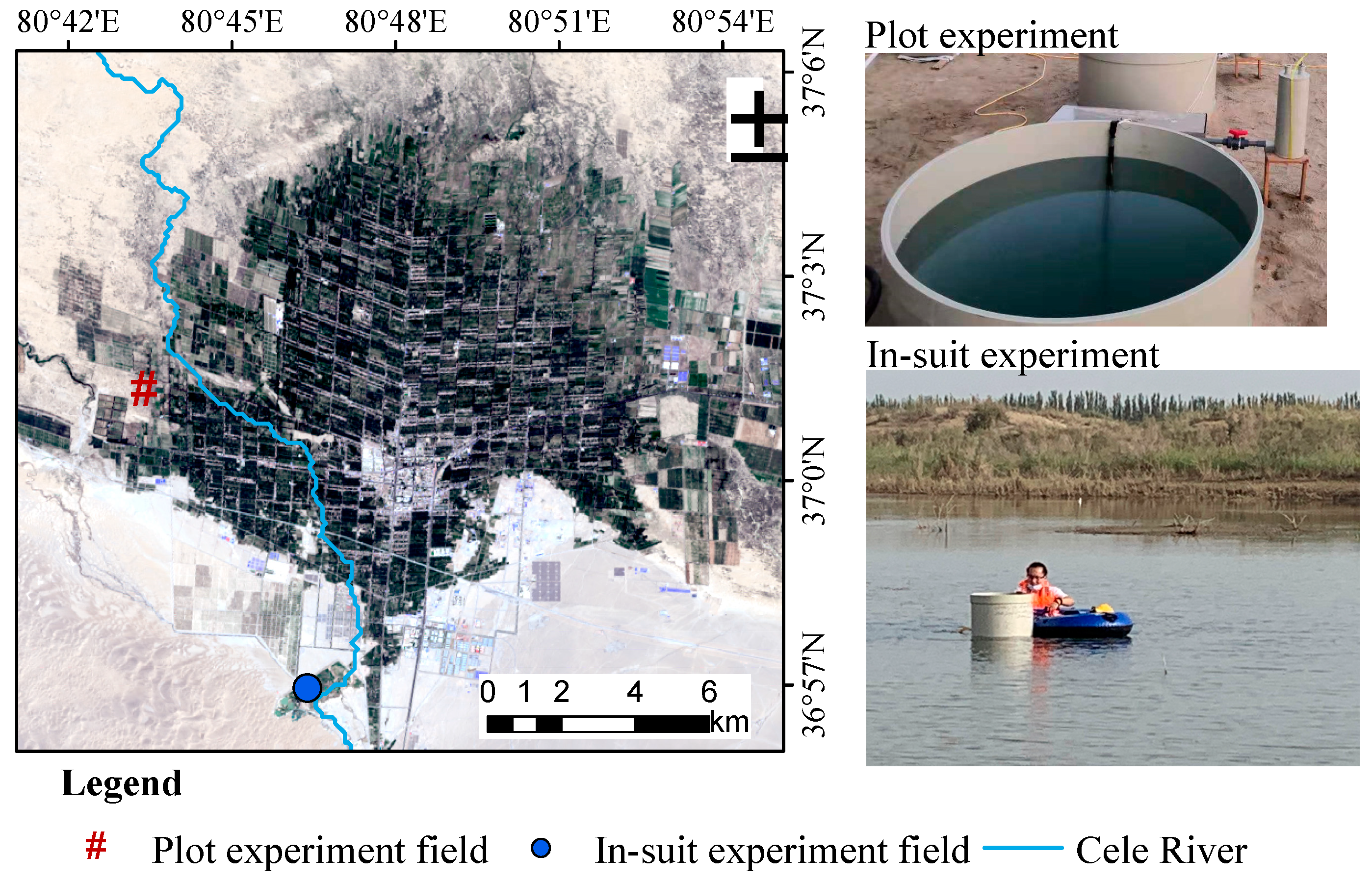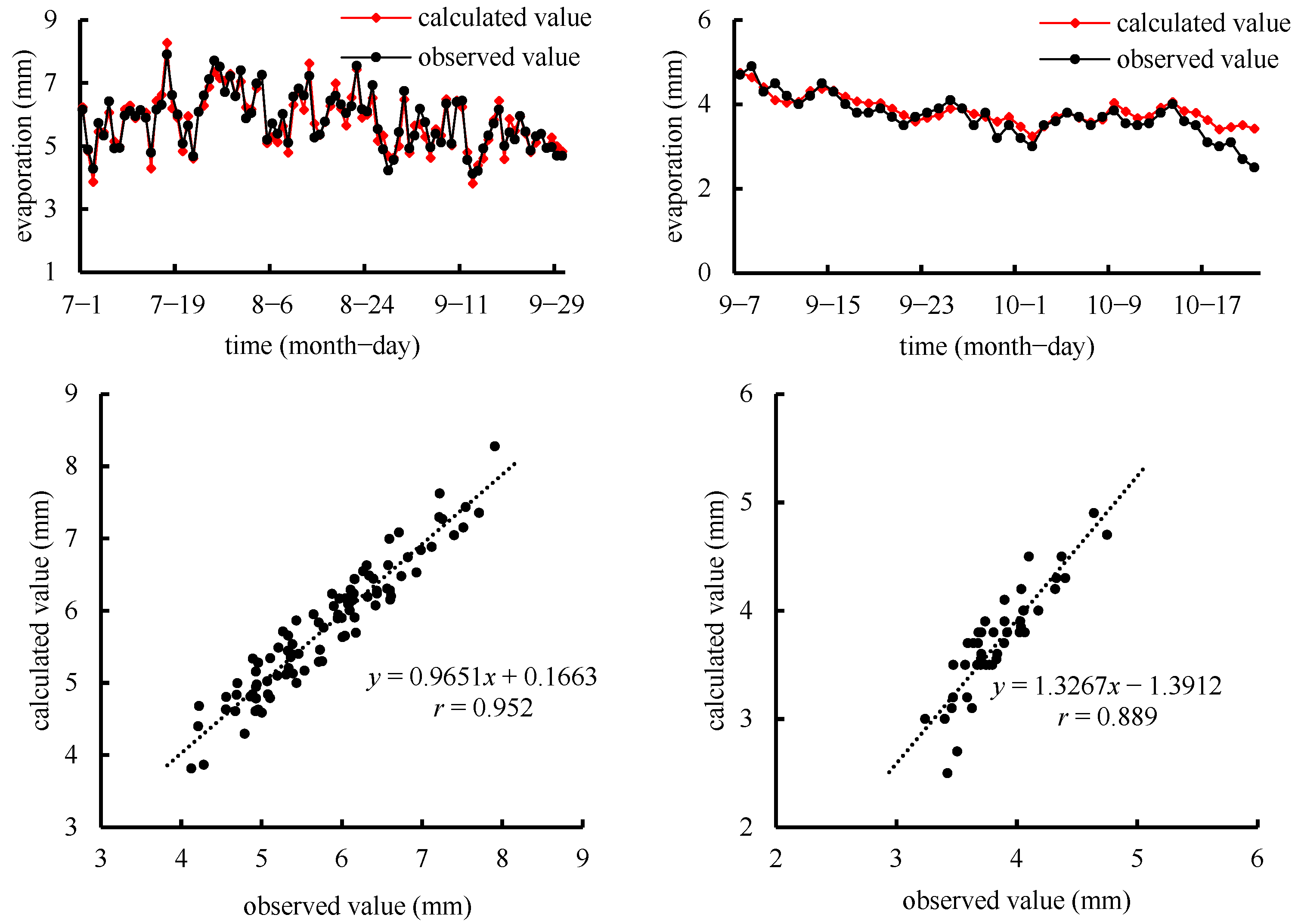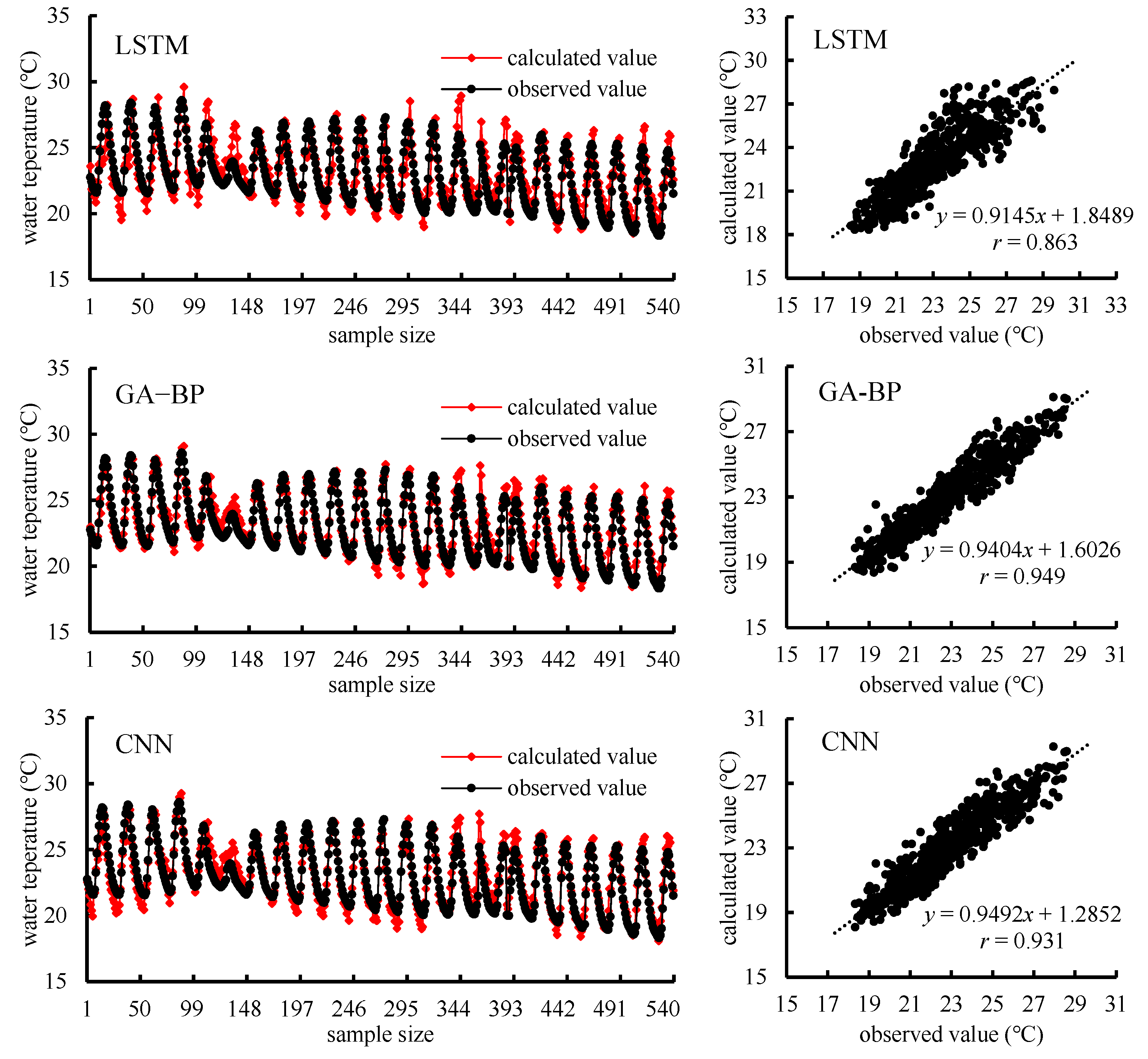A Study on Evaporation Calculations of Agricultural Reservoirs in Hyper-Arid Areas
Abstract
:1. Introduction
2. Materials and Methods
2.1. Overview of the Study Area
2.2. Experimental Design and Data Introduction
2.3. Methods
- (1)
- Energy balance method
- (2)
- Machine learning algorithm
- (3)
- Model performance indexes
3. Results
3.1. Comparison of Evaporation Calculation Results with Observed Values
3.2. Analysis of Water Surface Temperature Variation and Relate Influencing Factors
3.3. Analysis of Machine Learning Water Temperature Prediction Results
4. Discussion
4.1. Applicability of Energy Balance Method
4.2. Analysis of Factors Influencing the Water Surface Temperature
4.3. Main Limitations of the Machine Learning Algorithms
5. Conclusions
Author Contributions
Funding
Institutional Review Board Statement
Informed Consent Statement
Data Availability Statement
Conflicts of Interest
References
- Al-Mukhtar, M. Modeling the monthly pan evaporation rates using artificial intelligence methods: A case study in Iraq. Environ. Earth Sci. 2021, 80, 39. [Google Scholar] [CrossRef]
- Maria Antony Raj, M.; Kalidasa Murugavel, K.; Rajaseenivasan, T.; Srithar, K. A review on flash evaporation desalination. Desalination Water Treat. 2016, 57, 13462–13471. [Google Scholar] [CrossRef]
- Dimitriadou, S.; Nikolakopoulos, K.G. Evapotranspiration Trends and Interactions in Light of the Anthropogenic Footprint and the Climate Crisis: A Review. Hydrology 2021, 8, 163. [Google Scholar] [CrossRef]
- Sun, Z.; Zhu, G.; Zhang, Z.; Xu, Y.; Yong, L.; Wan, Q.; Ma, H.; Sang, L.; Liu, Y. Identifying surface water evaporation loss of inland river basin based on evaporation enrichment model. Hydrol. Processes 2021, 35, e14093. [Google Scholar] [CrossRef]
- Althoff, D.; Rodrigues, L.N.; da Silva, D.D. Evaluating Evaporation Methods for Estimating Small Reservoir Water Surface Evaporation in the Brazilian Savannah. Water 2019, 11, 1942. [Google Scholar] [CrossRef] [Green Version]
- Song, X.P.; Hansen, M.C.; Stehman, S.V.; Potapov, P.V.; Tyukavina, A.; Vermote, E.F.; Townshend, J.R. Global land change from 1982 to 2016. Nature 2018, 560, 639–643. [Google Scholar] [CrossRef]
- Huang, S.; Li, P.; Huang, Q.; Leng, G.; Hou, B.; Ma, L. The propagation from meteorological to hydrological drought and its potential influence factors. J. Hydrol. 2017, 547, 184–195. [Google Scholar] [CrossRef]
- Ogilvie, A.; Riaux, J.; Massuel, S.; Mulligan, M.; Belaud, G.; Le Goulven, P.; Calvez, R. Socio-hydrological drivers of agricultural water use in small reservoirs. Agric. Water Manag. 2019, 218, 17–29. [Google Scholar] [CrossRef]
- Ronco, P.; Zennaro, F.; Torresan, S.; Critto, A.; Santini, M.; Trabucco, A.; Zollo, A.L.; Galluccio, G.; Marcomini, A. A risk assessment framework for irrigated agriculture under climate change. Adv. Water Resour. 2017, 110, 562–578. [Google Scholar] [CrossRef]
- Majidi, M.; Alizadeh, A.; Farid, A.; Vazifedoust, M. Development and application of a new lake evaporation estimation approach based on energy balance. Hydrol. Res. 2018, 49, 1528–1539. [Google Scholar] [CrossRef]
- Majidi, M.; Alizadeh, A.; Farid, A.; Vazifedoust, M. Estimating Evaporation from Lakes and Reservoirs under Limited Data Condition in a Semi-Arid Region. Water Resour. Manag. 2015, 29, 3711–3733. [Google Scholar] [CrossRef]
- Valipour, M.; Sefidkouhi, M.A.G.; Raeini, M. Selecting the best model to estimate potential evapotranspiration with respect to climate change and magnitudes of extreme events. Agric. Water Manag. 2017, 180, 50–60. [Google Scholar] [CrossRef]
- Muhammad, M.K.I.; Nashwan, M.S.; Shahid, S.; Ismail, T.B.; Song, Y.H.; Chung, E.S. Evaluation of Empirical Reference Evapotranspiration Models Using Compromise Programming: A Case Study of Peninsular Malaysia. Sustainability 2019, 11, 4267. [Google Scholar] [CrossRef] [Green Version]
- Pillco Zolá, R.; Bengtsson, L.; Berndtsson, R.; Martí-Cardona, B.; Satgé, F.; Timouk, F.; Bonnet, M.P.; Mollericon, L.; Gamarra, C.; Pasapera, J. Modelling Lake Titicaca’s daily and monthly evaporation. Hydrol. Earth Syst. Sci. 2019, 23, 657–668. [Google Scholar] [CrossRef] [Green Version]
- Schoups, G.; Nasseri, M. GRACEfully Closing the Water Balance: A Data-Driven Probabilistic Approach Applied to River Basins in Iran. Water Resour. Res. 2021, 57, e2020WR029071. [Google Scholar] [CrossRef]
- Jing, W.; Yaseen, Z.M.; Shahid, S.; Saggi, M.K.; Tao, H.; Kisi, O.; Salih, S.Q.; Al-Ansari, N.; Chau, K.W. Implementation of evolutionary computing models for reference evapotranspiration modeling: Short review, assessment and possible future research directions. Eng. Appl. Comput. Fluid Mech. 2019, 13, 811–823. [Google Scholar] [CrossRef] [Green Version]
- Cai, W.; Ullah, S.; Yan, L.; Lin, Y. Remote Sensing of Ecosystem Water Use Efficiency: A Review of Direct and Indirect Estimation Methods. Remote Sens. 2021, 13, 2393. [Google Scholar] [CrossRef]
- Ghiat, I.; Mackey, H.R.; Al-Ansari, T. A Review of Evapotranspiration Measurement Models, Techniques and Methods for Open and Closed Agricultural Field Applications. Water 2021, 13, 2523. [Google Scholar] [CrossRef]
- Kwarteng, E.A.; Gyamfi, C.; Anyemedu, F.O.K.; Adjei, K.A.; Anornu, G.K. Coupling SWAT and bathymetric data in modelling reservoir catchment hydrology. Spat. Inf. Res. 2021, 29, 55–69. [Google Scholar] [CrossRef]
- Song, W.-K.; Chen, Y. Modelling of evaporation from free water surface. Geomech. Eng. 2020, 21, 237–245. [Google Scholar]
- Huth, T.; Hudson, A.M.; Quade, J.; Guoliang, L.; Hucai, Z. Constraints on paleoclimate from 11.5 to 5.0 ka from shoreline dating and hydrologic budget modeling of Baqan Tso, southwestern Tibetan Plateau. Quat. Res. 2015, 83, 80–93. [Google Scholar] [CrossRef]
- Dlouhá, D.; Dubovský, V.; Pospíšil, L. Optimal Calibration of Evaporation Models against Penman-Monteith Equation. Water 2021, 13, 1484. [Google Scholar] [CrossRef]
- Han, S.; Tian, F. Integration of Penman approach with complementary principle for evaporation research. Hydrol. Process. 2018, 32, 3051–3058. [Google Scholar] [CrossRef]
- Vargas Godoy, M.R.; Markonis, Y.; Hanel, M.; Kyselý, J.; Papalexiou, S.M. The Global Water Cycle Budget: A Chronological Review. Surv. Geophys. 2021, 42, 1075–1107. [Google Scholar] [CrossRef]
- Yin, J.; Calabrese, S.; Daly, E.; Porporato, A. The Energy Side of Budyko: Surface-Energy Partitioning From Hydrological Observations. Geophys. Res. Lett. 2019, 46, 7456–7463. [Google Scholar] [CrossRef] [Green Version]
- Sinclair, T.R. “Natural Evaporation from Open Water, Bare Soil and Grass” by Harold L. Penman, Proceedings of the Royal Society of London (1948) A193:120-146. Crop Sci. 2019, 59, 2297–2299. [Google Scholar] [CrossRef]
- Duan, Z.; Bastiaanssen, W.G.M. Evaluation of three energy balance-based evaporation models for estimating monthly evaporation for five lakes using derived heat storage changes from a hysteresis model. Environ. Res. Lett. 2017, 12, 024005. [Google Scholar] [CrossRef] [Green Version]
- Chen, B.; Zuo, H.; Gao, X.; Guo, Y.; Lu, S.; Yang, Y. Study on Pan Evaporation and Energy Change Process by Micro-Meteorological Method. Plateau Meteorol. 2017, 36, 87–97. [Google Scholar]
- Ouellet-Proulx, S.; St-Hilaire, A.; Boucher, M.A. Implication of evaporative loss estimation methods in discharge and water temperature modelling in cool temperate climates. Hydrol. Process. 2019, 33, 2867–2884. [Google Scholar] [CrossRef]
- Yaseen, Z.M.; Al-Juboori, A.M.; Beyaztas, U.; Al-Ansari, N.; Chau, K.W.; Qi, C.; Ali, M.; Salih, S.Q.; Shahid, S. Prediction of evaporation in arid and semi-arid regions: A comparative study using different machine learning models. Eng. Appl. Comput. Fluid Mech. 2020, 14, 70–89. [Google Scholar] [CrossRef] [Green Version]
- Cifuentes, J.; Marulanda, G.; Bello, A.; Reneses, J. Air Temperature Forecasting Using Machine Learning Techniques: A Review. Energies 2020, 13, 4215. [Google Scholar] [CrossRef]
- Ferreira, L.B.; Cunha, F.F.; Silva, G.H.; Campos, F.B.; Dias, S.H.; Santos, J.E. Generalizability of machine learning models and empirical equations for the estimation of reference evapotranspiration from temperature in a semiarid region. An. Acad. Bras. Cienc. 2021, 93, e20200304. [Google Scholar] [CrossRef] [PubMed]
- Bard, N.; Foerster, J.N.; Chandar, S.; Burch, N.; Lanctot, M.; Song, H.F.; Parisotto, E.; Dumoulin, V.; Moitra, S.; Hughes, E.; et al. The Hanabi challenge: A new frontier for AI research. Artif. Intell. 2020, 280, 103216. [Google Scholar] [CrossRef]
- Li, Z.; Pan, N.; He, Y.; Zhang, Q. Evaluating the best evaporation estimate model for free water surface evaporation in hyper-arid regions: A case study in the Ejina basin, northwest China. Environ. Earth Sci. 2016, 75, 295. [Google Scholar] [CrossRef]
- Shabani, S.; Samadianfard, S.; Sattari, M.T.; Mosavi, A.; Shamshirband, S.; Kmet, T.; Várkonyi-Kóczy, A.R. Modeling Pan Evaporation Using Gaussian Process Regression K-Nearest Neighbors Random Forest and Support Vector Machines; Comparative Analysis. Atmosphere 2020, 11, 66. [Google Scholar] [CrossRef] [Green Version]
- Zimmerman, N.; Presto, A.A.; Kumar, S.P.; Gu, J.; Hauryliuk, A.; Robinson, E.S.; Robinson, A.L.; Subramanian, R. A machine learning calibration model using random forests to improve sensor performance for lower-cost air quality monitoring. Atmos. Meas. Tech. 2018, 11, 291–313. [Google Scholar] [CrossRef] [Green Version]
- Kisi, O.; Choubin, B.; Deo, R.C.; Yaseen, Z.M. Incorporating synoptic-scale climate signals for streamflow modelling over the Mediterranean region using machine learning models. Hydrol. Sci. J. 2019, 64, 1240–1252. [Google Scholar] [CrossRef]
- Tezel, G.; Buyukyildiz, M. Monthly evaporation forecasting using artificial neural networks and support vector machines. Theor. Appl. Climatol. 2016, 124, 69–80. [Google Scholar] [CrossRef]
- Ghorbanzadeh, O.; Blaschke, T.; Gholamnia, K.; Meena, S.R.; Tiede, D.; Aryal, J. Evaluation of Different Machine Learning Methods and Deep-Learning Convolutional Neural Networks for Landslide Detection. Remote Sens. 2019, 11, 196. [Google Scholar] [CrossRef] [Green Version]
- Naghibi, S.A.; Ahmadi, K.; Daneshi, A.A. Application of Support Vector Machine, Random Forest, and Genetic Algorithm Optimized Random Forest Models in Groundwater Potential Mapping. Water Resour. Manag. 2017, 31, 2761–2775. [Google Scholar] [CrossRef]
- Alom, M.Z.; Taha, T.M.; Yakopcic, C.; Westberg, S.; Sidike, P.; Nasrin, M.S.; Hasan, M.; Van Essen, B.C.; Awwal, A.A.; Asari, V.K. A State-of-the-Art Survey on Deep Learning Theory and Architectures. Electronics 2019, 8, 292. [Google Scholar] [CrossRef] [Green Version]
- Wu, Y.; Yuan, M.; Dong, S.; Lin, L.; Liu, Y. Remaining useful life estimation of engineered systems using vanilla LSTM neural networks. Neurocomputing 2018, 275, 167–179. [Google Scholar] [CrossRef]
- Ahmadi, M.H.; Ahmadi, M.A.; Nazari, M.A.; Mahian, O.; Ghasempour, R. A proposed model to predict thermal conductivity ratio of Al2O3/EG nanofluid by applying least squares support vector machine (LSSVM) and genetic algorithm as a connectionist approach. J. Therm. Anal. Calorim. 2019, 135, 271–281. [Google Scholar] [CrossRef]
- Deo, R.C.; Kisi, O.; Singh, V.P. Drought forecasting in eastern Australia using multivariate adaptive regression spline, least square support vector machine and M5Tree model. Atmos. Res. 2017, 184, 149–175. [Google Scholar] [CrossRef] [Green Version]
- De Farias Mesquita, J.B.; Neto, I.E.L.; Raabe, A.; de Araújo, J.C. The influence of hydroclimatic conditions and water quality on evaporation rates of a tropical lake. J. Hydrol. 2020, 590, 125456. [Google Scholar] [CrossRef]
- Rodrigues, C.M.; Moreira, M.; Guimarães, R.C.; Potes, M. Reservoir evaporation in a Mediterranean climate: Comparing direct methods in Alqueva Reservoir, Portugal. Hydrol. Earth Sci. 2020, 24, 5973–5984. [Google Scholar] [CrossRef]
- Tanny, J.; Cohen, S.; Assouline, S.; Lange, F.; Grava, A.; Berger, D.; Teltch, B.; Parlange, M.B. Evaporation from a small water reservoir: Direct measurements and estimates. J. Hydrol. 2008, 351, 218–229. [Google Scholar] [CrossRef] [Green Version]
- Lensky, N.G.; Dvorkin, Y.; Lyakhovsky, V.; Gertman, I.; Gavrieli, I. Water, salt, and energy balances of the Dead Sea. Water Resour. Res. 2005, 41, 1–13. [Google Scholar] [CrossRef]
- Tan, Z.; Yao, H.; Zhuang, Q. A Small Temperate Lake in the 21st Century: Dynamics of Water Temperature, Ice Phenology, Dissolved Oxygen, and Chlorophyll a. Water Resour. Res. 2018, 54, 4681–4699. [Google Scholar] [CrossRef]
- Yang, K.; Yu, Z.; Luo, Y.; Zhou, X.; Shang, C. Spatial-Temporal Variation of Lake Surface Water Temperature and Its Driving Factors in Yunnan-Guizhou Plateau. Water Resour. Res. 2019, 55, 4688–4703. [Google Scholar] [CrossRef]
- Gooseff, M.N.; Strzepek, K.; Chapra, S.C. Modeling the potential effects of climate change on water temperature downstream of a shallow reservoir, Lower Madison River, MT. Clim. Change 2005, 68, 331–353. [Google Scholar] [CrossRef]
- Schmid, M.; Köster, O. Excess warming of a Central European lake driven by solar brightening. Water Resour. Res. 2016, 52, 8103–8116. [Google Scholar] [CrossRef]
- Hatmaja, R.B.; Wisha, U.J.; Radjawane, I.M.; Al Tanto, T. Correlation and coherence analysis between sea surface temperature (SST) and surface wind in the Equatorial Western Sumatra Waters. In Proceedings of the 1st International Conference On Tropical Meteorology and Atmospheric Sciences (ICTMAS), Bandung, Indonesia, 19–20 September 2018. [Google Scholar]
- Koue, J.; Shimadera, H.; Matsuo, T.; Kondo, A. Numerical Analysis of Sensitivity of Structure of the Stratification in Lake Biwa, Japan by Changing Meteorological Elements. Water 2018, 10, 1492. [Google Scholar] [CrossRef] [Green Version]
- Biazar, S.M.; Fard, A.F.; Singh, V.P.; Dinpashoh, Y.; Majnooni-Heris, A. Estimation of evaporation from saline water. Environ. Monit. Assess. 2020, 192, 694. [Google Scholar] [CrossRef]
- Ding, S.; Zhao, H.; Zhang, Y.; Xu, X.; Nie, R. Extreme learning machine: Algorithm, theory and applications. Artif. Intell. Rev. 2015, 44, 103–115. [Google Scholar] [CrossRef]
- Wang, P.; Zheng, X.; Ku, J.; Wang, C. Multiple-Instance Learning Approach via Bayesian Extreme Learning Machine. IEEE Access 2020, 8, 62458–62470. [Google Scholar] [CrossRef]






| Location | MAE | NSE | RMSE | r |
|---|---|---|---|---|
| plot experiment | 0.355 | 0.904 | 0.337 | 0.952 |
| in-situ experiment | 0.157 | 0.977 | 0.241 | 0.889 |
| P | RH | Ta | WS | Rn | |
|---|---|---|---|---|---|
| Tw | −0.548 ** | −0.315 ** | 0.554 ** | 0.141 ** | −0.227 ** |
| Methods | MAE | NSE | RMSE | r |
|---|---|---|---|---|
| RF | 0.336 | 0.968 | 0.464 | 0.982 |
| LSSVM | 0.340 | 0.967 | 0.468 | 0.971 |
| LSTM | 1.186 | 0.634 | 1.567 | 0.863 |
| GA-BP | 0.558 | 0.925 | 0.709 | 0.949 |
| CNN | 0.962 | 0.815 | 1.113 | 0.931 |
Publisher’s Note: MDPI stays neutral with regard to jurisdictional claims in published maps and institutional affiliations. |
© 2022 by the authors. Licensee MDPI, Basel, Switzerland. This article is an open access article distributed under the terms and conditions of the Creative Commons Attribution (CC BY) license (https://creativecommons.org/licenses/by/4.0/).
Share and Cite
Yin, C.; Liu, Y.; Gui, D.; Liu, Y.; Lv, W. A Study on Evaporation Calculations of Agricultural Reservoirs in Hyper-Arid Areas. Agriculture 2022, 12, 612. https://doi.org/10.3390/agriculture12050612
Yin C, Liu Y, Gui D, Liu Y, Lv W. A Study on Evaporation Calculations of Agricultural Reservoirs in Hyper-Arid Areas. Agriculture. 2022; 12(5):612. https://doi.org/10.3390/agriculture12050612
Chicago/Turabian StyleYin, Changjun, Yunfei Liu, Dongwei Gui, Yi Liu, and Wengai Lv. 2022. "A Study on Evaporation Calculations of Agricultural Reservoirs in Hyper-Arid Areas" Agriculture 12, no. 5: 612. https://doi.org/10.3390/agriculture12050612
APA StyleYin, C., Liu, Y., Gui, D., Liu, Y., & Lv, W. (2022). A Study on Evaporation Calculations of Agricultural Reservoirs in Hyper-Arid Areas. Agriculture, 12(5), 612. https://doi.org/10.3390/agriculture12050612





